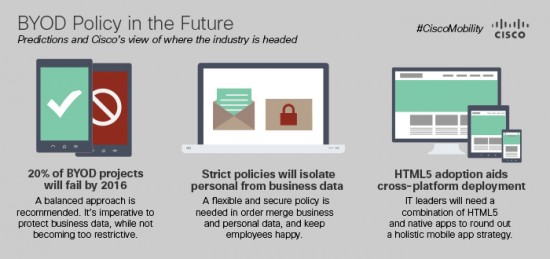































Gartner recently made three interesting predictions about mobility in the workplace. While the ideas are compelling, they only offer one-side of the story, and the solution.
In this blog post, I'll take a deeper look at each of these predictions and discuss why the future of mobility rests on IT leaders taking a balanced and strategic approach to security that focuses more on protecting the network and proprietary data and less on implementing overly broad restrictions.
Gartner Prediction#1: Twenty percent of BYOD projects will fail by 2016 due to IT's "heavy hand."
While the actual failure rate may be less than one-fifth, mobility efforts will fail if companies are too restrictive with MDM policies. Instead, a two-fold approach to supporting a BYOD environment from a security perspective is essential.
First, IT leaders should take a balanced approach to security that protects business-imperative network solutions and data. In most cases, blocking Angry Birds and Candy Crush is unnecessary and not scalable. With Apple and Google supporting over a million apps each (and counting), it can cost precious time and IT resources just trying to keep up with restricting non-threatening applications.
Secondly, IT leaders should be focused on encouraging users to use secure solutions. This will only grow more important as the explosion of new connections and various devices evident in today's Internet of Everything world creates more opportunity for malicious actors to utilize even more inroads to compromise users, networks, and data. By educating employees to take an active role in the security of their device, users can be empowered to report suspicious threats and have an open dialogue with IT teams.

Gartner Prediction#2: Strict mobility policies will drive employees to want to isolate personal data from business data.
I disagree that most employees want isolation of all business content. For example, my Contacts data is both corporate and personal. I have friends who work at Cisco and want to be able to access that information on one device. This capability is part of the beauty of BYOD. And as we start to see a merging of the "digital self", thanks in large part to the growing consumerization of IT and the rise of cloud technologies, the ability to save work and personal information in one place is going to become even more important.
However, this does not mean privacy is not dead. Employees don't want IT to access or change personal apps and content. In fact, a recent MobileIron study supports that the rising generation of workers value privacy in the workplace more than on social networks. According to the survey of over 3,000 workers across the United States, United Kingdom, and Germany, "employees over 55 were far more comfortable than 18 to 24 year olds with their company seeing their personal data."
These beliefs and behaviors will continue to help shape the future of mobility. With these concepts in mind, IT leaders must evaluate and deploy and a flexible and secure infrastructure that can support an open BYOD policy and mitigate advanced security threats.
Gartner Prediction#3: Mobile browsers will gain market share for app delivery for multiple platforms, and the role of HTML5 in solving issues that arise with the multiple platform problem.
As the majority of users are accustomed to an App Store delivery model, it is unlikely mobile browsers will become a delivery method for apps. It doesn't help that web bookmarks on mobile are completely broken. According to Business Insider Intelligence, only 20% of our time on mobile is spent in our browser.
However, all is not lost. HTML5 is a good technology to help solve the multiple platform problem, but it can't do everything. IT leaders will need a combination of HTML5 and native apps to round out a holistic mobile app strategy.
A good example of this is how at Cisco, our internal apps are designed to deliver mobile moments of productivity to our employees. We don't want employees spending time finding these apps, which is why we deployed Cisco eStore. Cisco eStore is our new internal app store powered by Cisco Prime Service Catalog. It is an essential part of our overall mobility strategy and one of the ways that we ensure employees are using secure, supported solutions.
As global mobile data traffic is set to significantly increase over the next few years, successful IT teams will continue to place the security and function of applications at the top of their mobility strategy.
The focus should be more on securing enterprise apps and data regardless of delivery method, and less on restricting use of these business-centric applications on employee-owned devices.
What are your thoughts about Gartner's predictions? Join the conversation, follow @CiscoMobility on Twitter,#FutureofMobility.
Additional Information:
 Tags quentes :
Mobilidade
Telemóvel
#Segurança
rede
Infra-estrutura
architecture
future of mobility
mobile device
mobile workspace
Tags quentes :
Mobilidade
Telemóvel
#Segurança
rede
Infra-estrutura
architecture
future of mobility
mobile device
mobile workspace